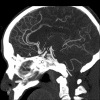A Simple Scoring Model for Prediction of Rupture Risk of Anterior Communicating Artery Aneurysms
- PMID: 31214103
- PMCID: PMC6554323
- DOI: 10.3389/fneur.2019.00520
A Simple Scoring Model for Prediction of Rupture Risk of Anterior Communicating Artery Aneurysms
Abstract
Background: The rupture risk of anterior communicating artery aneurysms (ACoAAs) has been known to be higher than that of aneurysms at other locations. Thus, the aim of this study is to investigate the clinical and morphological characteristics associated with risk factors for the rupture of ACoAAs. Methods: In total, 361 consecutive patients with 361 ACoAAs between August 2011 and December 2017 were retrospectively reviewed. Patients and ACoAAs were divided into ruptured and unruptured groups. In addition to clinical characteristics, ACoAA characteristics were evaluated by CT angiography (CTA). A multiple logistic regression analysis was used to identify the independent risk factors associated with ACoAA rupture. The assignment score of these variables depends on the β coefficient. A receiver operating characteristic (ROC) curve analysis was used to calculate the optimal thresholds. Results: The multiple logistic regression model revealed that A1 dominance [odds ratio (OR) 3.034], an irregular shape (OR 3.358), and an aspect ratio ≥1.19 (AR; OR 3.163) increased the risk of rupture, while cerebral atherosclerosis (OR 0.080), and mean diameters ≥2.48 mm (OR 0.474) were negatively correlated with ACoAA rupture. Incorporating these five factors, the ROC analysis revealed that the threshold value of the multifactors was one, the sensitivity was 88.3%, and the specificity was 66.0%. Conclusions: The scoring model is a simple method that is based on A1 dominance, irregular shape, aspect ratio, cerebral atherosclerosis, and mean diameters from CTA and is of great value in the prediction of the rupture risk of ACoAAs.
Keywords: CT angiography; anterior communicating artery aneurysms; morphological parameter; patient characteristics; predictive scoring model; risk factors.
Figures



Similar articles
-
Are Morphologic Parameters Actually Correlated with the Rupture Status of Anterior Communicating Artery Aneurysms?World Neurosurg. 2015 Nov;84(5):1278-83. doi: 10.1016/j.wneu.2015.05.060. Epub 2015 Jun 6. World Neurosurg. 2015. PMID: 26054869
-
Risk Factors for the Rupture of Bifurcation Intracranial Aneurysms Using CT Angiography.Yonsei Med J. 2016 Sep;57(5):1178-84. doi: 10.3349/ymj.2016.57.5.1178. Yonsei Med J. 2016. PMID: 27401649 Free PMC article.
-
Patient and aneurysm characteristics associated with rupture risk of multiple intracranial aneurysms in the anterior circulation system.Acta Neurochir (Wien). 2016 Jul;158(7):1367-75. doi: 10.1007/s00701-016-2826-0. Epub 2016 May 10. Acta Neurochir (Wien). 2016. PMID: 27165300
-
Anterior Communicating Artery Aneurysm Morphology and the Risk of Rupture.World Neurosurg. 2018 Jan;109:119-126. doi: 10.1016/j.wneu.2017.09.118. Epub 2017 Sep 27. World Neurosurg. 2018. PMID: 28958928 Review.
-
Microneurosurgical management of anterior communicating artery aneurysms.Surg Neurol. 2008 Jul;70(1):8-28; discussion 29. doi: 10.1016/j.surneu.2008.01.056. Epub 2008 May 2. Surg Neurol. 2008. PMID: 18452980 Review.
Cited by
-
Identification of ruptured intracranial aneurysms using the aneurysm-specific prediction score in patients with multiple aneurysms with subarachnoid hemorrhages- a Chinese population based external validation study.BMC Neurol. 2022 Jun 1;22(1):201. doi: 10.1186/s12883-022-02727-w. BMC Neurol. 2022. PMID: 35650546 Free PMC article.
-
Impact of spatial and temporal stability of flow vortices on vascular endothelial cells.Biomech Model Mechanobiol. 2023 Feb;22(1):71-83. doi: 10.1007/s10237-022-01632-y. Epub 2022 Oct 21. Biomech Model Mechanobiol. 2023. PMID: 36271263 Free PMC article.
-
Clinical and Morphological Factors for Ruptured Anterior Communicating Artery Aneurysms.Vasc Health Risk Manag. 2023 Jun 30;19:371-377. doi: 10.2147/VHRM.S415213. eCollection 2023. Vasc Health Risk Manag. 2023. PMID: 37408543 Free PMC article.
-
Disturbed flow's impact on cellular changes indicative of vascular aneurysm initiation, expansion, and rupture: A pathological and methodological review.J Cell Physiol. 2022 Jan;237(1):278-300. doi: 10.1002/jcp.30569. Epub 2021 Sep 6. J Cell Physiol. 2022. PMID: 34486114 Free PMC article. Review.
-
CLINICAL CHARACTERISTICS AND MORPHOLOGICAL PARAMETERS ASSOCIATED WITH RUPTURE OF ANTERIOR COMMUNICATING ARTERY ANEURYSMS.Acta Clin Croat. 2022 Aug;61(2):284-294. doi: 10.20471/acc.2022.61.02.15. Acta Clin Croat. 2022. PMID: 36818935 Free PMC article.
References
-
- Villablanca JP, Duckwiler GR, Jahan R, Tateshima S, Martin NA, Frazee J, et al. . Natural history of asymptomatic unruptured cerebral aneurysms evaluated at CT angiography: growth and rupture incidence and correlation with epidemiologic risk factors. Radiology. (2013) 269:258–65. 10.1148/radiol.13121188 - DOI - PubMed
-
- Thompson BG, Brown RD, Jr, Amin-Hanjani S, Broderick JP, Cockroft KM, Connolly ES, Jr, et al. . Guidelines for the management of patients with unruptured intracranial aneurysms: a guideline for healthcare professionals from the American Heart Association/American Stroke Association. Stroke. (2015) 46:2368–400. 10.1161/STR.0000000000000070 - DOI - PubMed
-
- Greving JP, Wermer MJ, Brown RD, Jr, Morita A, Juvela S, Yonekura M, et al. . Development of the phases score for prediction of risk of rupture of intracranial aneurysms: a pooled analysis of six prospective cohort studies. Lancet Neurol. (2014) 13:59–66. 10.1016/S1474-4422(13)70263-1 - DOI - PubMed
LinkOut - more resources
Full Text Sources
Research Materials

